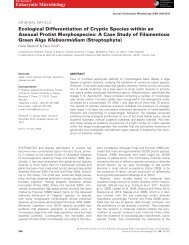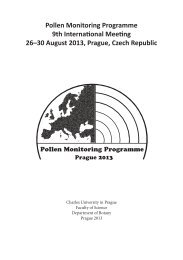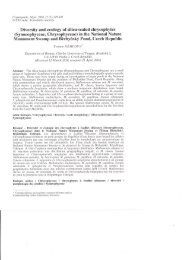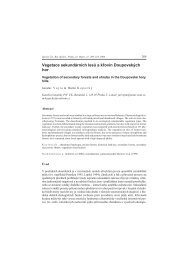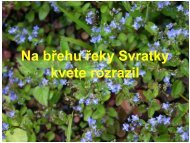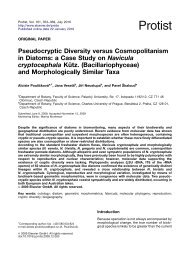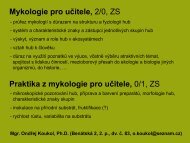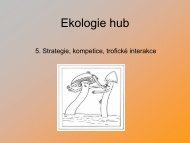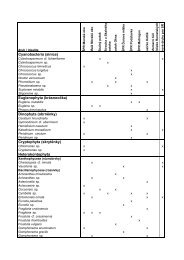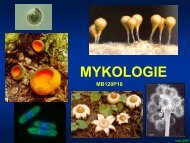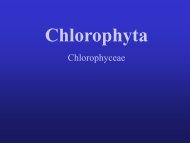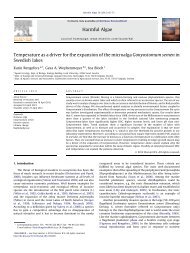Trebouxiophyceae, Chlorophyta - (S)FTP hesla na Botany
Trebouxiophyceae, Chlorophyta - (S)FTP hesla na Botany
Trebouxiophyceae, Chlorophyta - (S)FTP hesla na Botany
You also want an ePaper? Increase the reach of your titles
YUMPU automatically turns print PDFs into web optimized ePapers that Google loves.
Paper 2. Chloroplast morphology in Asterochloris<br />
tained from the Culture Collection of Algae at the University of Göttingen (SAG) and the<br />
Culture Collection of Algae at the University of Texas at Austin (UTEX), respectively (Table<br />
1). Observations of the algal isolates were made on cultures grown on 2% agar slants of<br />
Bold´s Basal Medium (BBM) as modified by Bischoff & Bold (1963). All cultures were<br />
grown under standard conditions: at a temperature of 15 °C, under an illumi<strong>na</strong>tion of 5-15<br />
μmol m -2 s -1 in a Helkama C5G cool box.<br />
Light and confocal microscopy<br />
Observations using a conventio<strong>na</strong>l light microscope and a confocal microscope were made<br />
regularly at 7 day intervals on 2-11 week old cultures. The pure algal samples were examined<br />
by a Leica TCS SP2 confocal laser scanning microscope, equipped with an Argon-Krypton<br />
laser, using a 488 nm excitation line and an AOBS filter free system collecting emitted light<br />
between 498 and 700 nm. A Leica 63x/1.4 N.A. oil immersion objective fitted on a Leica DM<br />
IRE2 inverted microscope was used. A series of optical sections through chloroplasts were<br />
captured and used for 3-dimensio<strong>na</strong>l reconstruction of their morphology. The autofluorescence<br />
of the chlorophyll was exploited for the visualization of the chloroplast structure. For<br />
the fi<strong>na</strong>l image processing we used Leica Confocal Software, version 2.61 (Leica Microsystems<br />
Heidelberg GmbH) and the Image J 1.34p program (Abramoff et al. 2004).<br />
DNA extraction, PCR and DNA sequencing<br />
Total genomic DNA was extracted from lyophilized algal cultures following the standard<br />
CTAB protocol (Doyle & Doyle 1987), with minor modifications. Algal DNA was resuspended<br />
in sterile dH2O and amplified by the polymerase chain reaction (PCR). The ITS1,<br />
ITS2, and 5.8S rDNA regions were amplified using the algal-specific primer nr-SSU-1780-5´<br />
(5´-CTG CGG AAG GAT CAT TGA TTC-3´; Piercey-Normore & DePriest 2001) and a universal<br />
primer ITS4-3´ (5´-TCC TCC GCT TAT TGA TAT GC-3´; White et al. 1990). All<br />
PCR were performed in 20 μl reaction volumes (15.1 μl sterile Milli-Q Water, 2 μl 10´ PCR<br />
buffer (Sigma), 0.4 μl dNTP (10 μM), 0.25 μl of primers (25 pmol/ml), 0.5 μl Red Taq DNA<br />
Polymerase (Sigma) (1U/ml), 0.5 μl of MgCl2, 1 μl of DNA (5 ng/ml)). After an initial de<strong>na</strong>turing<br />
step at 95 °C for 5 min, 35 cycles of de<strong>na</strong>turing at 95 °C for 1 min, annealing at 60 °C<br />
for 1 min and elongation at 72 °C for 1 min were performed, followed by a fi<strong>na</strong>l extension at<br />
72 °C for 7 min. The PCR products were quantified on 1% agarose gel stained with ethidium<br />
bromide and cleaned with GENOMED Jetquick kit. The purified amplification products were<br />
sequenced with a set of sequencing primers described above (nr-SSU-1780-5´ and ITS4-3´)<br />
using the protocol for the DNA sequencing kit (ABI Prism Big-Dye termi<strong>na</strong>tor cycle sequencing<br />
ready reaction, Applied BioSystems). Purified sequencing reactions were run on 3100-<br />
Table 1. Species and strains of Asterochloris used in this study.<br />
Phycobiont Strain number a<br />
Isolated from lichen Locality Collector Year<br />
Asterochloris<br />
phycobiontica<br />
SAG 26.81 Anzi<strong>na</strong> carneonivea<br />
Italy, Trento,<br />
Madon<strong>na</strong> di Campiglio.<br />
Tschermak-Woess E. 1976<br />
Asterochloris<br />
phycobiontica<br />
LEP 9 Lepraria neglecta<br />
Ukraine, East Carpathians,<br />
Breskul Mt.<br />
Slavíková Š. 2004<br />
Asterochloris sp. LEP 10 Lepraria borealis<br />
Bulgaria, Stara plani<strong>na</strong> Mts,<br />
Central Balkan NP.<br />
Slavíková Š. & Slavík M. 2004<br />
Asterochloris sp. LEP 36 Lepraria sp.<br />
Czech Republic,<br />
Máslovická stráň NR.<br />
Peksa O. & Jindráková Z. 2006<br />
Trebouxia<br />
pyriformis<br />
UTEX 1712 Cladonia squamosa<br />
USA, Massachusetts,<br />
Leverett<br />
Hutchinson W.A. 1969<br />
a<br />
SAG - culture collection of algae at the University of Göttingen (http://www.epsag.uni-goettingen.de/html/sag.html);<br />
UTEX - culture collection at the University of Austin, Texas (http://www.bio.utexas.edu/research/utex/); LEP – authors’<br />
strain desig<strong>na</strong>tion.<br />
32



